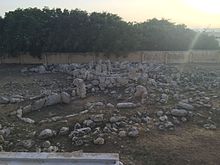Temple of Kordin
The temples of Kordin are located in a densely populated area east of the south side of the Grand Harbor , not far from the temples of Tarxien and the hypogeum of Ħal-Saflieni on Malta . Most of them are destroyed above ground. The area originally consisted of the temple complexes I, II and III, which were built between 3,800 and 2,500 BC. Were erected. The Kordin III Temple has been included in the National Inventory of the Cultural Assets of the Maltese Islands .
Kordin I
35 ° 52 ′ 52.7 ″ N , 14 ° 30 ′ 17.6 ″ E
Thetemple,which presumablydatesto theMġarr phase, is very poorly preserved. It is unclear about its (possibly five-lobed) shape, as well as whether it is a single building or the remains of an ensemble.
Kordin II
35 ° 52 '52.3 " N , 14 ° 30' 22.3" O
In Kordin II is the very complex residues of at least two temples from the mġarr phase, one of which could have been western siebenlappig. However, due to the destruction, it lacks the area in which the head apse should have been. The remnants of the other systems do not allow any clear statements about the shape, but could belong to two other systems.
Kordin III
35 ° 52 ′ 37.4 ″ N , 14 ° 30 ′ 32.6 ″ E
Thebest preserved temple complexdespite being hit by a bomb inWorld War IIis further away from Grand Harbor near Tarxien. It was used from theŻebbuġ phase.
The two- and three-lobed stone temples here are among the oldest on the island. They originated in the Ġgantija phase. A two-lobed (without a head apse) east temple, which is rare in temple culture, was added to the older three-lobed western temple. The covering, the almost round forecourt and its exedra were conceptually included in the conversion to a double temple . A separate, poorly preserved, presumably older temple (north temple) completes the complex. The forecourt and the axis of the west temple still have an almost undamaged paving, which is extremely rare. The gate building (entrance) is separated from the outside area as well as from the inside area by low threshold stones. Likewise, the two apses and the head niche, which are still unpaved in the left area, are separated from the central aisle. In addition to altars and wall niches, a multiple mortar with seven depressions in a 2.75 meter long limestone block is the specialty of this square. Kordin III is enclosed and closed by walls. Visits are only possible with an official company.
literature
- Joachim von Freeden: Malta and the architecture of its megalithic temples. Scientific Book Society, Darmstadt 1993, ISBN 3-534-11012-9 .
- Nicholas C. Vella: The prehistoric Temples at Kordin III. Coordin. Heritage Books, Sta Venera 2004, ISBN 99932-39-87-9 .

